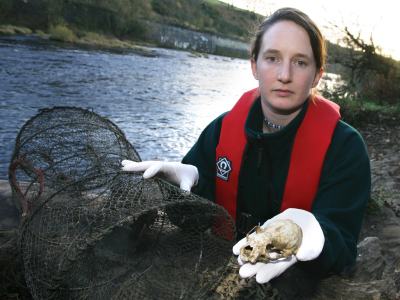The Environment Agency are appealing to local people to help stamp out the use of illegal traps set in rivers which are threatening protected wildlife such as otters, water voles and crayfish.
Illegal traps are being set in the North East of England and a trap recovered recently from the River Blyth contained an otter which had drowned as a result of being trapped in it. Similar illegal traps have been found in other areas of the country.
Trapping in rivers requires a licence from the Environment Agency which is only granted if the Agency is convinced that the trapping does not pose a threat to protected wildlife. At present, licences for crayfish trap licenses traps are only granted for scientific monitoring purposes.
Environment Agency wildlife officer Rachael McFarlane said “We only licence traps of the correct design, and where they are placed in appropriate locations. The trap we found recently had too large an entrance which allowed the otter to enter when attracted either by the bait or a fish in the trap. Once it had entered the trap it could not escape and sadly drowned.”
 Illegal traps also pose threats to other rare species such as water voles and crayfish. Traps should have small escape holes in the top to allow water voles that enter them to swim out and illegal traps often don’t. A major threat to the Region’s important crayfish populations is the spread of crayfish plague. Introducing traps that may have been used in other rivers risks spreading this disease. Unfortunately the recent interest in wild food may be encouraging people to trap crayfish without knowing the dangers that they are causing.
Illegal traps also pose threats to other rare species such as water voles and crayfish. Traps should have small escape holes in the top to allow water voles that enter them to swim out and illegal traps often don’t. A major threat to the Region’s important crayfish populations is the spread of crayfish plague. Introducing traps that may have been used in other rivers risks spreading this disease. Unfortunately the recent interest in wild food may be encouraging people to trap crayfish without knowing the dangers that they are causing.
Environment Agency team leader Jim Heslop added “Wild food shouldn’t be at the expense of our wildlife heritage. We will not grant licenses for traps to catch crayfish for consumption in the North East Region. People should be aware that our enforcement staff are on the look out for these traps and if caught, offenders will be prosecuted. Everyone can help by keeping their eyes open on the riverbank. If you see a trap let the Environment Agency know so that it can be checked out.”








